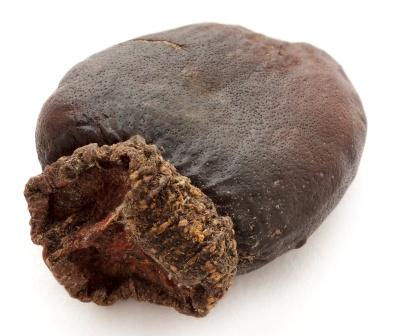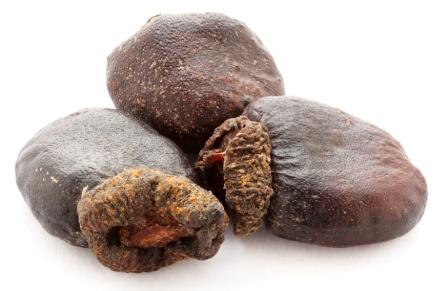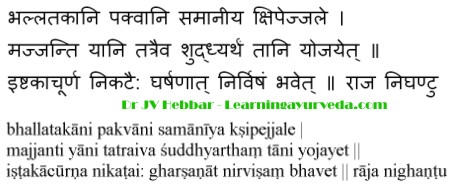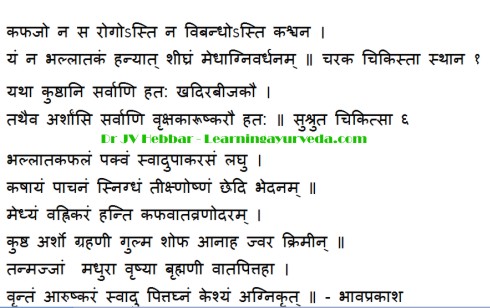Bhallataka: Marking Nut Uses, Qualities, Purification, Side Effects
Bhallataka is one of the most powerful and fast acting Ayurvedic herbs. It is used extensively in piles, skin diseases, etc. Its botanical name is Semecarpus anacardium. It belongs to Anacardaceae family (Amra Kula). Since it is very hot in potency, it is used only after purification procedures.

Table of Contents
Vernacular names, Sanskrit synonyms
Names in different languages:
Hindi name – Bhilawa, belatak, bhela, bhilava
English name – Marking nut, Ink nuts
Tamil name – cenkottai, arutkaram, ceraankottai, erimuki, sengottai, seraangottai.
Kannada name – aginimukhi, bhallataka,chera, gerkayi,kerubija.
Malayalam name – alakkuceru, cera, cerkkotta, shengotta, thenkotta.
Urdu name – baladur, bhilanvana.
Persian name – biladur.
Arab name -beladin, hab-el-kalb.
Telugu name -bhallaathaki, gudova,jeedi, thummeda maamidi, shenta, simidi.
Marathi name – bibba, bibha, bibo, bibwa.
Etymology
The word semecarpus in Greek means simeon – marking/tracing, carpus in Greek means nut, Anacardium means – like cardium i.e heart shaped marking nut.
Classical categorization
Charaka –
Deepaneeya – Group of herbs that promotes digestion,
Bhedaniya – group of herbs that cause mild purgation,
Kushtaghna – group of herbs that are useful in skin diseases
Mutrasangrahaneeya – group of herbs that cause urine retention.
Sushruta and Vagbhata – Nyagrodhadi, Mustadi gana.
Bh. pr . Ni – Hareetakyadi varga

Habitat
Common in hotter parts of India.
Varities
Susruta and Nighanu Ratnakara
Bhallataka and Nadi Bhallataka
Morphology
Medium sized tree up to 30 – 50 feet height.
Bark – Grey in colour and exudes an irritant secretions on incising
Leaves – Simple, obovate – oblong, ashy gray
Inflorescence – Compound panicle
Flowers – Small, greenish yellow with long flower stalk
Fruits – drupaceous nut, Heart shaped, Green when raw and turned to black on ripening. Fruits are attached to fleshy orange coloured receptacle which is edible
Seeds – Pendulous
Medicinal properties
Rasa (taste) – Katu (pungent), Tikta (Bitter), Kashaya (Astringent)
Guna (qualities) – Laghu (light to digest), Teekshna (piercing), Snigdha (Unctuous)
Vipaka – Madhura – undergoes sweet taste conversion after digestion.
Veerya – Ushna – hot in potency
Pharmacological Action
Anti cancerous
Anti bacterial
Cardiac depressant
Anti Allergic
Hypotensive
Anti Arthritic
Anti inflammatory

Dose (Matra)
Taila – 10 – 20 drops
Ksirapaka – 30 ml
Fatal dose
More than 10 g
Fatal period
12 -24 hours
Side effects
In higher doses Bhallataka will cause
Blisters on tongue and throat
Increased Thirst and sweats
Heartburn
Oliguria
Swelling
Renal failure
Gastrointestinal tract infection
Phyto constituents
Nuts contain – Bhilawanol, Bioflavonoids, Anacardic acid
Purification of Bhallataka
Bhallataka Shodhana –
Because it is very hot in nature, its mere skin contact may cause boils. To reduce its hot potency and toxicity, it is subjected to purification procedures.
Ripe seeds of Bhallataka are taken, and put into water. Only those which sink are used for purification and the rest are discarded.
The seed is cut into two and kept immersed in dry brick powder for sometime. During this time, the dry brick powder absorbs all the strong pungent oil of Bhallatak, reducing its pungency and making it usable for medicinal purposes.
Therapeutic uses
There is no Kapha imbalance disease, no constipation, which can’t be cured by Bhallataka. It improves intelligence and promotes digestion.
Khadira seeds help to treat all skin diseases. Similarly, all hemorrhoids can be well treated using Bhallataka.
In case of cerebral infarction, Bhallataka is used.

Bhallatak fruit qualities
After ripening, it is
Svadupaka rasa – sweet in taste.
Laghu – light to digest
Kashaya – astringent
Pachana – helps in digestion
Snigdha – unctuous
Teekshna – piercing
Ushna – hot
Chedana – has cutting, slicing effect
Bhedi – induces purgation.
Medhya – improves intelligence
Vahnikara – promotes digestion
Kaphavatahara -balances Kapha and Vata
Vranahara – induces quick wound healing
Udarahara – useful in ascites
Kushta – useful in skin diseases
Arshahara – useful in piles
Grahani – Useful in malabsorption syndrome
Gulma – Useful in gaseous distention of abdomen
Shopha -Relieves inflammation
Anaha – relieves bloating
Jwara – useful in fever
Krimi- useful in worm infestation.
Bhallataka seed kernel
is sweet, aphrodisiac,
Bruhmani – nutritious, balances Vata Dosha and Pitta Dosha
Bark is good for hair and improves digestion.
Bhallataka and cancer
There are many Ayurvedic formulations that are prepared with Bhallataka, used in cancer treatment. As of now, there is no specific lead that is to prove its efficacy beyond doubt. Nevertheless, Marking nut is one of the potential herbs having scope against cancer
How to counter side effects of Bhallatak?
For its allergic reactions like rash, itching and swelling, the antidotes used externally are coconut oil, rala ointment, ghee, coriander leaves pulp or butter mixed with musta (Cyperus rotundus) – A cream is prepared and administered. Coconut and sesame seeds are also beneficial to eradicate the side effects.
Milk medicated with bhallataka or bhallataka modaka mitigates skin diseases like scabies, eczema, ringworm infestations.
As a nervine tonic, it is beneficial in the diseases due to vata, like sciatica, paralysis, facial palsy, epilepsy, rheumatic conditions and also as a brain tonic.
The combination, bhallatak, haritaki, tila (sesame seeds) powders with jaggery, awards excellent results in chronic rheumatic disorders.
Parpataka kashaya or Palashamool kashaya subsides the poisonous effects caused by Bhallataka seeds or oil. – Vaidya Sara Sangraha – Parishishta
If you are suffering with blisters due to exposure to bhallataka oil, then eating plenty of grated coconut helps to cool down the burning sensation and also to heal the blisters fast.
Collection of fruits of Bhallataka
Reference: Charaka Samita Chikitsa 1.2/13
The fruits
- which are not damaged,
- free from physical defects,
- full of Rasa (taste),
- having full size,
- ripe in potency (veerya) and
- which resemble ripe fruits of Jambu (Jamun fruit)
Time when it is to be collected:
In the months of Suchi or Jyestha (May-June) and Shukra or Ashadha (June-July)
Storage:
It is stored for 4 months inside a heap of Yava – Barley (Hordeum vulgare) or Masha (Black gram)
Method of Administration of Bhallatak Rasayan
- Is done in the month of Sahas or Agrahayana (November-December) or Sahasya, i.e Pushya (December-January),
- It is administered to a patient after his body has been smeared with cooling, unctuous and sweet herbs. (This is because, Bhallataka is very hot in nature and may cause excessive burning sensation in the patient).
- In the beginning, 10 fruits of Bhallataka should be well boiled in 8 parts of water.
- After boiling, when 1/8th of water remains, it is filtered, added with milk and given to the patient after his mouth has been smeared with ghee.
- Ten fruits should be added every day by one fruit till the number becomes thirty and thereafter, it should be decreased by one fruit per day till it reaches the original number – ten.
- It should not be further increased because thirty fruits of Bhallataka is the maximum dose.
- Following this procedure, one thousand Bhallatakas can be administered.
Pathya – Recommended diet
- After digestion, the person should take the rice of Shali or Shashtika along with milk and ghee.
- After administration for a few days, the person should take milk only twice per day. (Milk acts as a coolant and will take away the hot effect of Bhallatak).
By the use of this recipe, one lives for one hundred years and gains such other excellent results as are described in paragraph 4, 5 and 6 above.[13]
Interaction with medicines, supplements
Can this be used while taking Homeopathic medicine?
Yes. This product does not react with homeopathic medicine.
Can this medicine be continued while taking supplements like multivitamin tablets, Omega 3 fatty acids etc?
Yes. Generally, this product goes well with most dietary supplements. However, if you are taking more than one product per day, please consult your doctor for an opinion.
With western
medicines
Seek your
doctor’s advice if you are taking this product along with other western
(allopathic / modern) medicines. Some Ayurvedic herbs can interact with modern
medicine.
If both Ayurvedic and allopathic medicines are advised together, then it is
best to take Allopathic medicine first, wait for 30 minutes and then take the
Ayurvedic medicine.
Ayurvedic medicines with Bhallataka
Bhallataka Rasayana – useful in skin diseases and as anti aging medicine.
Amrita Bhallataka Ghrita – Useful in skin diseases and hemorrhoids.
Sanjivani Vati – useful in poisoning and fever.
De Pile Tablet – Used in the treatment of hemorrhoids.
Sanskrit synonyms:
Arushkara – produces wounds, merely by skin contact
Shophakrut – causes inflammation on skin contact
Dhanurbija – Fruits are obliquely ovoid
Tailabija – Fruits as oily contents
Bhalli – The juice of Bhallataka is very corrosive
Bhedana – Bhallataka alleviate Arbuda
Ranjaka – Juice cause redness to the skin
Vira vriksha – Potent plant
Agnika, Agnimukha – as hot as fire
bhallataka,
bhutanashana, Krimighna – kills microbes
Kshatakshataru, prithakabija, shailabeeja,
sphotahetu, shophakrit – exposure to its volatile oils can cause blisters, swelling and inflammation.
vahninama, virataru.
Sthanika Karma (Systemic Action)
External Application – Can cause skin blisters, Anti poisonous. External application of its paste in the vaginal area causes abortion. Fumigation with bhallataka seed is indicated in Hemorrhoids
Internal administration-
Nervous system- Nervous strengthening, and promoting intellect (Medhya). Indicated in Epilepsy, Sciatica, Hemiplegia, etc. In Sciatica bhallataka processed with milk can be given.
Digestive System – Digestive, carminative, liver stimulant, Anti helminthic. Indicated in abdominal distension, constipation, phantom tumor, malabsorption syndrome, hook worm infestation. Best medicine for Hemorrhoids (Sushkarsas), Correct blood circulation of the liver.
Circulatory System – Stimulate heart, Beneficial in edema, enlargement of lymph nodes etc.
Respiratory system – Helps to eliminate kapha dosha, indicated in cough, breathing disorders etc.
Excretory System – Initially it increases urine production, later when it starts acting on the kidney it reduces urine production. further increase of dose can lead to hematuria. Indicated in diabetes patients
Reproductive system – Aphrodisiac, stimulates the nerves of male genital organs, and improves semen quantity. indicated in dysmenorrhea.
Satmikarana – Indicated in Obesity as it cause Medodhatu soshana (Scraping action on fat tissue)
Tvak (Skin) – Indicated in all types of skin diseases, Rheumatic skin lesions, leukoderma.
Tapakrama – Indicated in fever, stimulate sweat production
Satmikarana – Strengthening the body, indicated in Mamsarbuda (swelling related to muscles)
Pliha – Along with Black cumin, chebulic myrobalan and jaggery it can be given in splenomegaly
Contra indication
Administration of Bhallataka is contraindicated in kids, pregnant ladies, old age, people of pitta body constitution
Pathya (diet during bhallataka intake)
Should not take hot, spicy, sour, salty foods. Avoid excess heat, sun exposure, hot weather etc.
Should not take kakarashtaka groups of herbs mentioned in Ayurveda text books.
Can take milk, ghee, sugar, coconut, sesame etc.
Poisonous effect (lakshanas)of Bhallataka
Consumption of unpurified bhallataka or over dosage can cause excess sweating, thirst, itching and burning sensation over anal region. Reduce urine production, or discolored / bloody urine. Swelling / itching over body











33 comments
Rahul
Is this same as cashew nut sir? Is there any reference of cashew in ayurveda texts?
Dr J V Hebbar MD(Ayu)
Hi, it is different than cashew nut. I will write about cashew nuts in a few weeks time.
dheeraj
Hello,
How to get pure bhilawa oil without mixing in coconut or sesame oil. In market ,, bhilawa or marking nut is boiled in any other oil then they make oil. Its wrong way. I know its very hot or pungent in original. But i need original one , i know how to dilute it or use it. But tell me how to extract it or which company sell that original , rare bhilawa oil.
thanks,
dheeraj
Delhi
aditya
can the toxicity be reduced or completely removed without affecting its medcinal values? as workers in rural areas gets exposed, that cause skin rashes and the oil extraction method causes respiratory problems
pls reply
Dr J V Hebbar MD(Ayu)
Hi, with the described method of purification, Bhallataka is purified and used in various Ayurvedic medicines, everyday. This ancient method also ensures that the medicinal values are retained in it.
Snehal
Dear Dr, in the above article especially for RA factor , in what form bhallatak should be taken plz elaborate. As haritaki n seasame powder r easily available but bhaalatak is not.
Dr J V Hebbar MD(Ayu)
Hi, Bhallataka cannot be used on one’s own, like haritaki or sesame powder.
shahrukh hirani
For preparing bhallataka hair oil for stimulating hair follicles, how much quantity of bhallataka powder should be taken in 100 ml oil ?
Dr J V Hebbar MD(Ayu)
Just 2 grams per 100 ml of Shuddha Bhallataka.
CHHAVI TRIVEDI
Where can we get it from ?
Dalbeer
Hi, I want to use Narsingh churna as a rejuvenator. I consume alcohol also & have cholesterol issues. Since this churna contains bhilawa , is it safe for me?
Dr J V Hebbar MD(Ayu)
Cannot be assured. You will need to consult an Ayurveda doctor directly.
Rohit
Hi i have applied bhilwa oil on my scalp for hair treatment, i used oil directly from nuts without any purification. Now my skin is red and lot of rashes are there also swelling is getting increased. Please suggest some remedies
Priyanka
From where i can get bhallatak oil…. Presently I’m living in aligarh
Dr J V Hebbar MD(Ayu)
Not known.
adi
u can search online or you can approach a trustworthy Ayurveda medical nearby…
Thang Viet Nguyen
I read AFI and see that dose of shudha bhallataka as follows:
1-2 gams in ksheera form
3-6 gams in kalka
what is kalka? if it is paste of shudha bhallataka so I think this dose is very high compare to ksheera form.
Can you explain! Thank you very much.
Dr J V Hebbar MD(Ayu)
Hi, Kalka is in paste form. It is a mistake. If Kalka is made with other ingredients, then the dose can be correct.
Jyoti
1) How can this medicine be kapha-vata hara as well as vata-pitta hara at the same time (as mentioned in the above article at different locations)?
2) What is the basis of the claim that it is effective against cancer? any anecdotal evidence or preliminary study? something?
regards
Dr J V Hebbar MD(Ayu)
Dosha effect of Seed kernel is vatapitta hara. Fruit is vatakaphahara.
It is indicated in Gulma – abdominal tumor by Bhavaprakasha and Raja Nighantu.
Dr J V Hebbar MD(Ayu)
Please try here
https://dir.indiamart.com/impcat/bhilawa-seeds.html
Niraj
What are the cancer treatment options with this bhilama and what product are recommended for it.
Dr J V Hebbar MD(Ayu)
Hi, Bhallataka rasayana is used extensively in cancer treatment.
Aditya
I have a question pls guide, if I dry the nuts before shudhana using hot air oven the oil seeps out of the nut; will this decrease the oil content and medicinal effect?
Also what is the best method to remove the moisture of nut???
Dr J V Hebbar MD(Ayu)
Hi, better to dry it under sunshade and not in an oven.
Niraj
So how do we take Bhallataka rasayana for cancer ? Do we need to check with some doctor or administer ourself ?
Sachin
Hiiii….we have lots of bibvas in our village….our people directly take the ripen fruits from tree and eat it….what can be possible side effects of this and also of eating lots of bibvas….thanks
Dr J V Hebbar MD(Ayu)
Hi, ripe Bhallatak fruit benefits – I have given in the above article. It does not have side effects.
Kota
How to use these for preparing hair oil ?
Dr J V Hebbar MD(Ayu)
It is not commonly used in hair oil preparation.
dave dharmen
मेने कही पढ़ा था की भिलावा बालो को भीर से काला करने के लिए उपयोगी है . उसे हेयर ओइल केसे बनाते है ? कहा गया है की अगर सफ़ेद बकरिया भी भिलावा खाती है तो काली हो जाती है?
khushi agrawal
Thanks for sharing this site.